Forums
- Forums
- Duggy's Reference Hangar
- RAF Library
- Hawker Tempest
Hawker Tempest
Post a reply
- Go to Previous topic
- Go to Next topic
- Go to Welcome
- Go to Introduce Yourself
- Go to General Discussion
- Go to Screenshots, Images and Videos
- Go to Off topic
- Go to Works in Progress
- Go to Skinning Tips / Tutorials
- Go to Skin Requests
- Go to IJAAF Library
- Go to Luftwaffe Library
- Go to RAF Library
- Go to USAAF / USN Library
- Go to Misc Library
- Go to The Ops Room
- Go to Made in Germany
- Go to Campaigns and Missions
- Go to Works in Progress
- Go to Juri's Air-Raid Shelter
- Go to Campaigns and Missions
- Go to Works in Progress
- Go to Skinpacks
- Go to External Projects Discussion
- Go to Books & Resources
-
2 years agoSun Sep 10 2023, 10:46amDuggy
 Main AdminDesign and development
Main AdminDesign and development
During development of the earlier Hawker Typhoon, the design team, under the leadership of Sydney Camm, had already planned out a series of design improvements; these improvements cumulated in the Hawker P. 1012, otherwise known as the Typhoon II or Thin-Wing Typhoon. Although the Typhoon was generally considered to be a good design, Camm and his design team were disappointed with the performance of its wing, which had proved to be too thick in its cross section, and thus created airflow problems which inhibited flight performance, especially at higher altitudes and speeds where it was affected by compressibility. The Typhoon's wing, which used a NACA 4 digit series wing section, had a maximum thickness-to-chord ratio of 19.5 per cent (root) to 12 per cent (tip), in comparison to the Supermarine Spitfire's 13.2 per cent tapering to 6 per cent at the tip, the thinner design being deliberately chosen to reduce drag. In addition, there had been other issues experienced with the Typhoon, such as engine unreliability, insufficient structural integrity, and the inability to perform high altitude interception duties.
In March 1940, engineers were assigned to investigate the new low–drag laminar flow wing developed by NACA in the United States, which was later used in the North American P-51 Mustang. A laminar flow wing adopted for the Tempest series had a maximum thickness-to-chord ratio of 14.5 per cent at the root, tapering to 10 per cent at the tip. The maximum thickness of the Tempest wing was set further back at 37.5 per cent of the chord versus 30 per cent for the Typhoon's wing, reducing the thickness of the wing root by five inches on the new design.The wingspan was originally greater than that of the Typhoon at 43 ft (13.1 m), but the wingtips were later "clipped" and the wing became shorter; 41 ft (12.5 m) versus 41 ft 7 in (12.7 m).
The wing planform was changed to a near-elliptical shape to accommodate the 800 rounds of ammunition for the four 20 mm Hispano cannons, which were moved back further into the wing. The new wing had greater area than the Typhoon's,however, the new wing design sacrificed the leading edge fuel tanks of the Typhoon: to make up for this loss in capacity, Hawker engineers added a new 21 in (53 cm) fuel bay in front of the cockpit, with a 76 Igal (345 L) fuel tank.In addition, two inter-spar wing tanks, each of 28 Igal (127 L), were fitted on either side of the centre section and, starting with late model Tempest Vs, a 30 Igal (136 L) tank was carried in the leading edge of the port wingroot, giving the Tempest a total internal fuel capacity of 162 Igal (736 L).
Another important feature of the new wing was Camm's proposal that the radiators for cooling the engine be fitted into the leading edge of the wing inboard of the undercarriage. This eliminated the distinctive "chin" radiator of the Typhoon and improved aerodynamics.A further improvement of the Tempest wing over that of the Typhoon was the exceptional, flush-riveted surface finish, essential on a high performance laminar flow airfoil. The new wing and airfoil, and the use of a four-bladed propeller, acted to eliminate the high frequency vibrations that had plagued the Typhoon. The design team also chose to adopt the new Napier Sabre IV engine for the Tempest, drawings of which had become available to Hawker in early 1941.
In February 1941, Camm commenced a series of discussions with officials within the Ministry of Aircraft Production on the topic of the P.1012.In March 1941 of that year, clearance to proceed with development of the design, referred to at this point as the Typhoon II, was granted. At this point, work was undertaken by a team of 45 draughtsmen at Hawker's wartime experimental design office at Claremont, Esher to convert the proposal into technical schematics from which to commence manufacture. In March 1941, the Air Ministry issued specification F.10/41 that had been written to fit the aircraft. By October 1941, development of the proposal had advanced to the point where the new design was finalised.
Prototypes
On 18 November 1941, a contract was issued by the Air Ministry for a pair of prototypes of the "Typhoon Mark II"; the new fighter was renamed "Tempest" on 28 February 1942.Complications were added to the Tempest program by external factors in the form of engine issues: the Rolls-Royce Vulture engine and corresponding Hawker Tornado aircraft which was being developed in parallel were both terminated. Due to this previous experience on other programs, the Air Ministry was sufficiently motivated to request that a total of six Tempest prototypes be built using different engines so that, if a delay hit one engine, an alternative powerplant would already be available. This measure turned out to be prudent, as engine development was not trouble-free on some of the variants of the Tempest.
The six prototypes built were as follows:
One Tempest Mk.I (serial number HM599), equipped with the Napier Sabre Mk.IV engine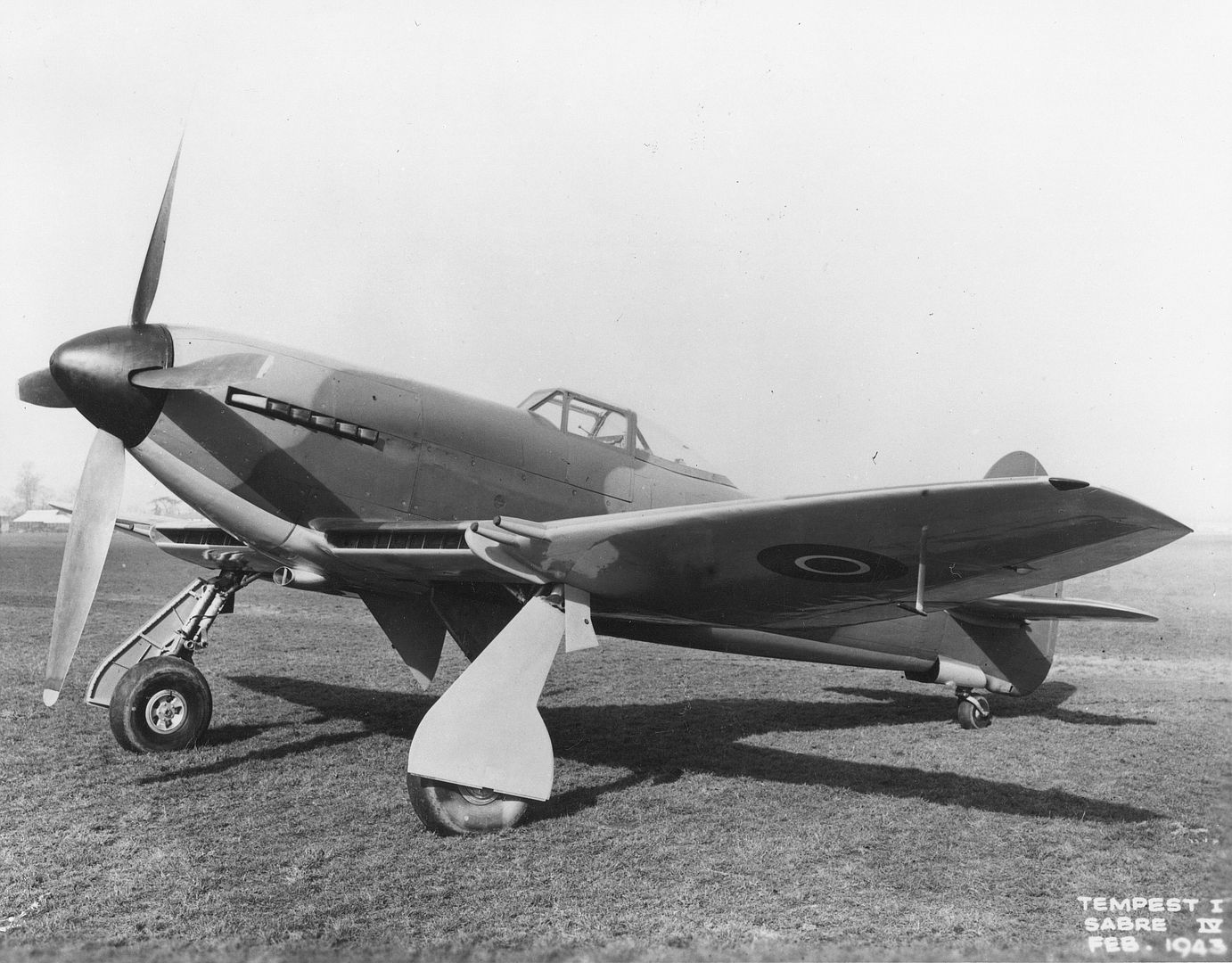



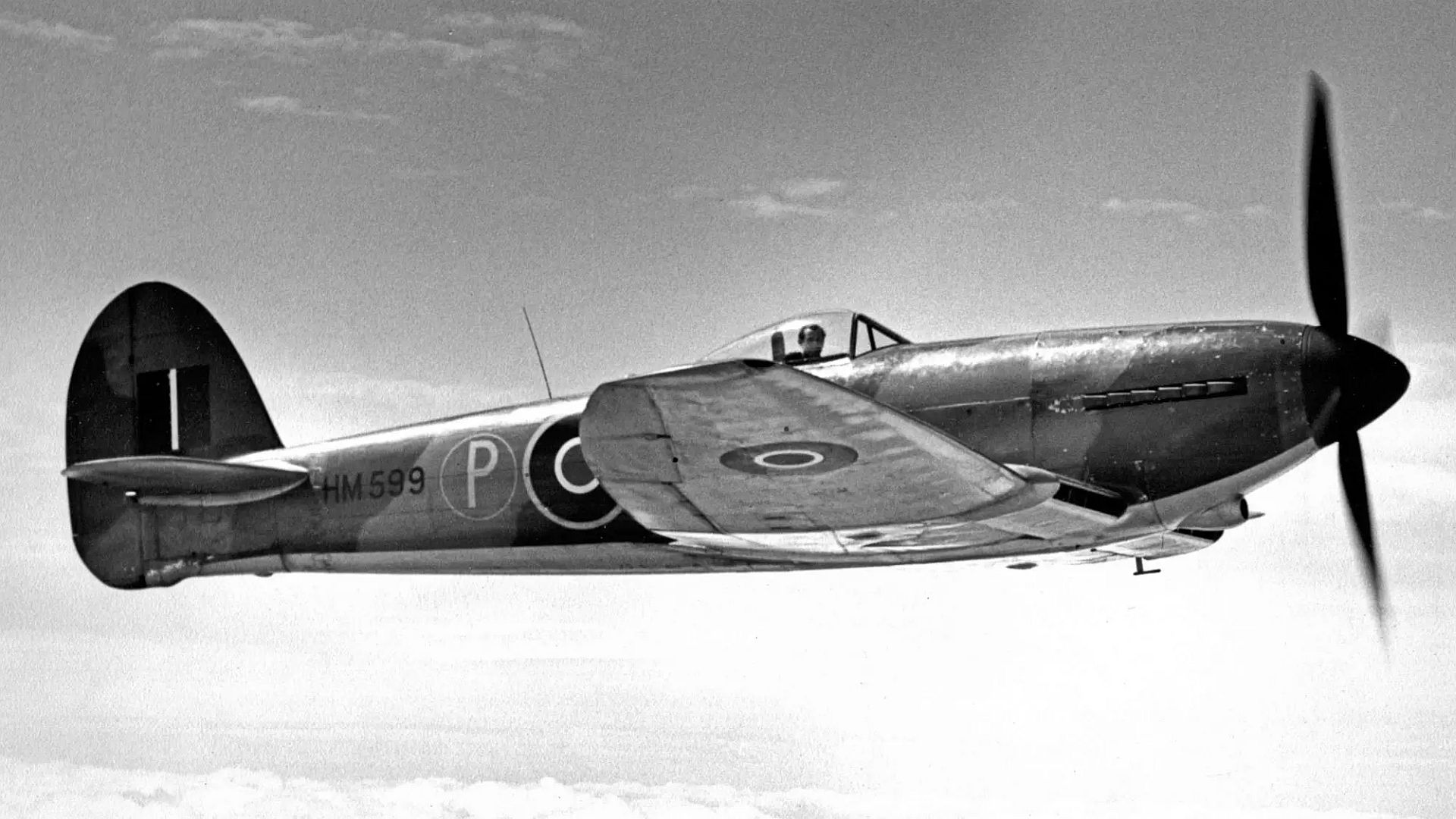
Two Tempest Mk.II (serial numbers LA602 and LA607), equipped with the Bristol Centaurus Mk.IV engine (LA607 later receiving a
Centaurus Mk.V)LINK -- http://axis-and-allies-paintworks.com/e107_plugins/forum/forum_viewtopic.php?id=18641
One Tempest Mk.III (serial number LA610), equipped with the Rolls-Royce Griffon 85 engine (originally planned for the Griffon IIB)
One Tempest Mk.IV (serial number LA614), which was never completed but planned to be equipped with a Griffon 61 engine
One Tempest Mk.V (serial number HM595), equipped with the Napier Sabre Mk.II engine



The Tempest Mk.I featured other new features, such as a clean single-piece sliding canopy in place of the car-door framed canopy, and it used wing radiators instead of the "chin" radiator. Due to development difficulties with the Sabre IV engine and its wing radiators, the completion of the Mk.I prototype, HM599, was delayed, and thus it was the Mk.V prototype, HM595, that would fly first.
On 2 September 1942, the Tempest Mk.V prototype, HM595, conducted its maiden flight, flown by Philip Lucas from Langley, Berkshire, England. HM595, which was powered by a Sabre II engine, retained the Typhoon's framed canopy and car-style door, and was fitted with the "chin" radiator, similar to that of the Typhoon. It was quickly fitted with the same bubble canopy fitted to Typhoons, and a modified fin that almost doubled the vertical tail surface area, made necessary because the directional stability with the original Typhoon fin had been reduced over that of the Typhoon by the longer nose incurred by the new fuel tank. The horizontal tailplanes and elevators were also increased in span and chord; these were also fitted to late production Typhoons.Test pilots found the Tempest a great improvement over the Typhoon in performance; in February 1943 the pilots from the A&AEE at Boscombe Down reported that they were impressed by "a manoeuvrable and pleasant aircraft to fly with no major handling faults"
On 24 February 1943, the second prototype HM599 first flew, representing the "Tempest Mk.I" equipped with the Napier Sabre IV engine; this flight had been principally delayed by protracted problems and slippages encountered in the development of the new Sabre IV engine.HM599 was at first equipped with the older Typhoon cockpit structure and vertical tailplane. The elimination of the "chin" radiator did much to improve overall performance, leading to the Tempest Mk.I quickly becoming the fastest aircraft that Hawker had built at that time, having attained a speed of 466 mph (750 km/h) during test flights.
On 27 November 1944, the Tempest Mk.III prototype, LA610, conducted its first flight; it was decided to discontinue development work on the Mk.III, this was due to priority for the Griffon engine having been assigned to the Spitfire instead.Work on the Tempest Mk.IV variant was abandoned without any prototype being flown at all. The Tempest Mk.II, which was subject to repeated delays due to its Centaurus powerplant, was persisted with, but would not reach production in time to see service during the Second World War.Continual problems with the Sabre IV meant that only the single Tempest Mk.I (HM599) was built; consequently, Hawker proceeded to take the Sabre II-equipped "Tempest V" into production instead.
In August 1942, even before the first flight of the prototype Tempest V had been conducted, a production order for 400 Tempests was placed by the Air Ministry. This order was split, with the initial batch of 100 being Tempest V "Series I"s, powered by the 2,235 hp (1,491 kW) Sabre IIA series engine, which had the distinctive chin radiator, while the rest were to have been produced as the Tempest I, equipped with the Sabre IV and leading-edge radiators. These 300 Tempest Is were intended to replace an order for a similar quantity of Typhoons for the Gloster Aircraft Company. As it transpired, the difficulties with the Sabre IV and the wing radiators led to this version never reaching production, the corresponding order was switched to 300 Tempest V "Series 2"s instead.
Tempest Mk.V
During early 1943, a production line for the Tempest Mk.V was established in Hawker's Langley facility, alongside the existing manufacturing line for the Hawker Hurricane.Production was initially slow, claimed to be due to issues encountered with the rear spar. On 21 June 1943, the first production Tempest V, JN729, rolled off the production line and its maiden flight was conducted by test pilot Bill Humble.
During production of the first batch of 100 Tempest V "Series Is", distinguishable by their serial number prefix JNxxx, several improvements were progressively introduced and were used from the outset on all succeeding Tempest V "Series 2s", with serial number prefixes EJ, NV and SN. The fuselage/empennage joint originally featured 20 external reinforcing "fishplates", similar to those fitted to the Typhoon, but it was not long before the rear fuselage was strengthened and, with the fishplates no longer being needed, the rear fuselage became detachable. The first series of Tempest Vs used a built-up rear spar pick-up/bulkhead assembly (just behind the cockpit) which was adapted from the Typhoon. Small blisters on the upper rear wing root fairing covered the securing bolts. This was later changed to a new forged, lightweight assembly which connected to new spar booms: the upper wing root blisters were replaced by small "teardrop" fairings under the wings.
The first 100 Tempest Vs were fitted with 20 mm (.79 in) Hispano Mk.IIs with long barrels which projected ahead of the wing leading edges and were covered by short fairings; later production Tempest Vs switched to the short-barrelled Hispano Mk.Vs, with muzzles flush with the leading edges. Early Tempest Vs used Typhoon-style 34 by 11 inch (83.4 by 28 cm) five-spoke wheels, but most had smaller 30 by 9 inch (76.2 by 22.9 cm) four-spoke wheels.The new spar structure of the Tempest V also allowed up to 2,000 lb (907 kg) of external stores to be carried underneath the wings. As a result, several early production Tempest V aircraft underwent extensive service trials at Boscombe Down for clearance to be fitted with external stores, such as one 250–1,000 lb (110–450 kg) bomb or eight 60 lb (27 kg) RP-3 rockets under each wing. On 8 April 1944, the Tempest Mk.V attained general clearance to carry such ordnance, but few Tempest Mk.V deployed bombs operationally during the war. Rockets were never used operationally during the war.
As in all mass-produced aircraft, there may have been some overlap of these features as new components became available. In mid-to-late 1944 other features were introduced to both the Typhoon and Tempest: A Rebecca transponder unit was fitted, with the associated aerial appearing under the portside centre section. A small, elongated oval static port appeared on the rear starboard fuselage, just above the red centre spot of the fuselage roundel. This was apparently used to measure the aircraft's altitude more accurately.
Unusually, in spite of the Tempest V being the RAF's best low- to medium-altitude fighter, it was not equipped with the new Mk.IIC gyroscopic gunsight (as fitted in RAF Spitfires and Mustangs from mid-1944), which would have considerably improved the chances of shooting down opposing aircraft. Tempest pilots continued to use either the Type I Mk.III reflector gunsight, which projected the sighting graticule directly onto the windscreen, or the Mk.IIL until just after the Second World War, when the gyro gunsight was introduced in Tempest IIs.
Two Tempest Vs, EJ518 and NV768, were fitted with Napier Sabre Vs and experimented with several different Napier-made annular radiators, with which they resembled Tempest IIs. This configuration proved to generate less drag than the standard "chin" radiator, contributing to an improvement in the maximum speed of some 11 to 14 mph. NV768 was later fitted with a ducted spinner, similar to that fitted to the Fw 190 V1.
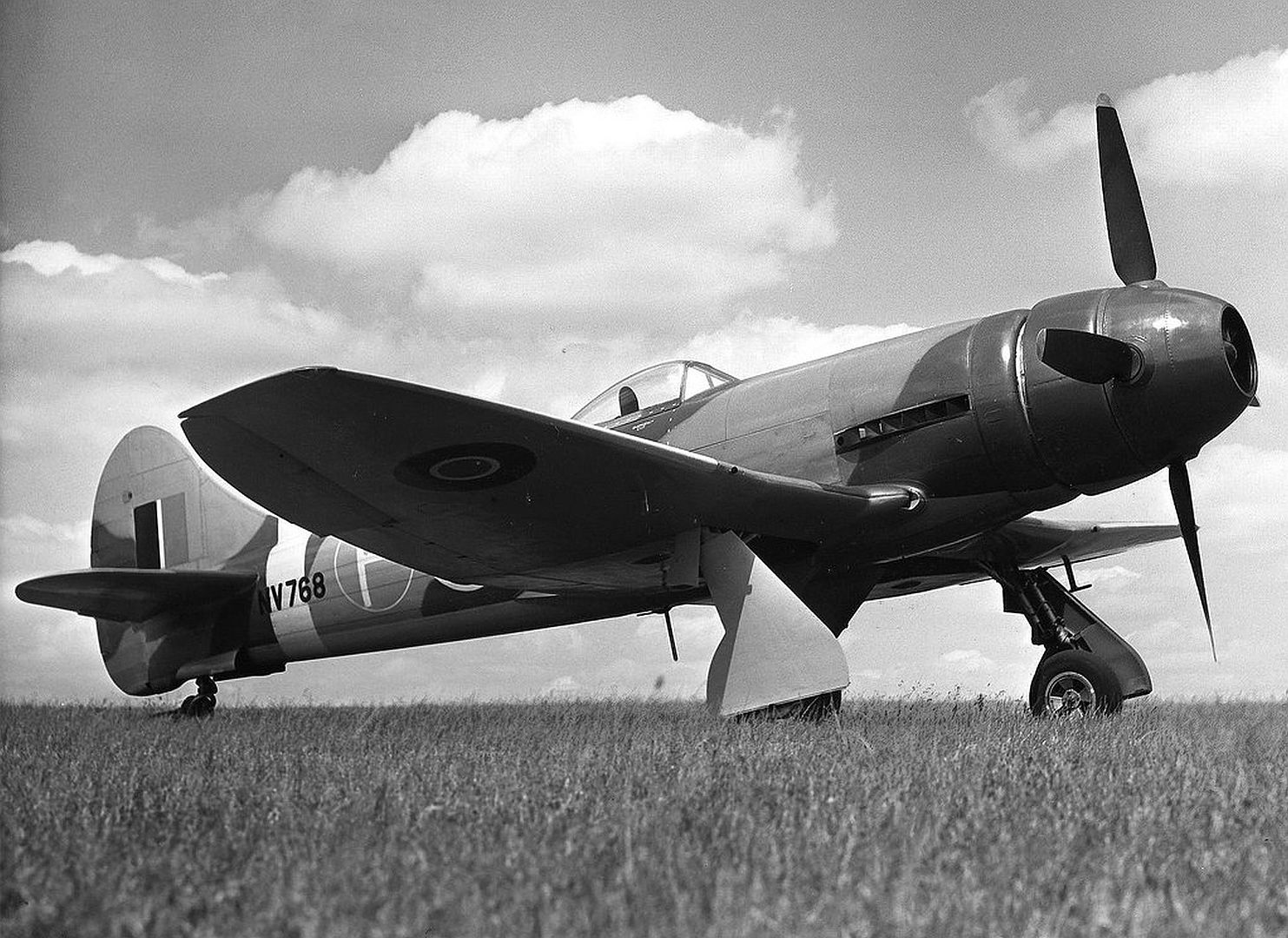



Another experimental Tempest V was SN354, which was fitted with two experimental underwing Vickers 47 mm Class P anti-tank guns at the end of the war. These guns were part of a project to develop a 47 mm airborne anti-tank gun, of which several company designs existed.The Vickers design was called PV, for Class P, Vickers. The PV guns were housed in long slim streamlined gun pods carried on the bombracks and had 38 rounds each. Surviving photographs suggests that the 20 mm wing guns were removed for this installation. Testing of the guns revealed that the weapon had potential, but no production was undertaken.







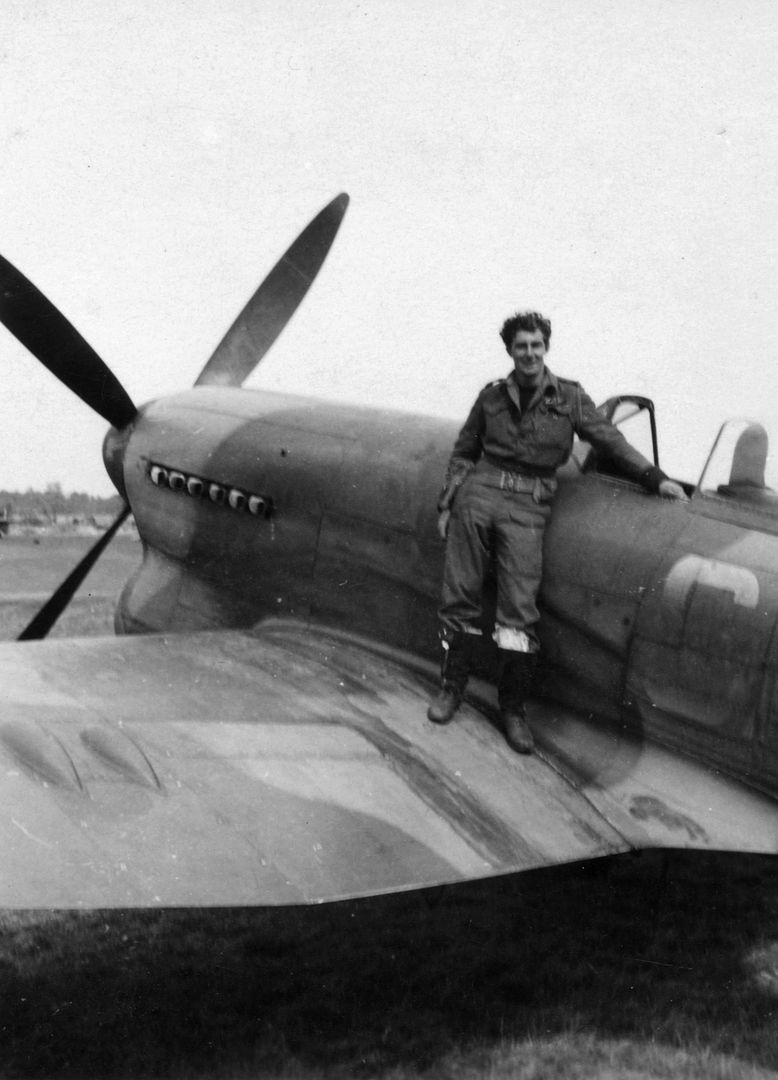










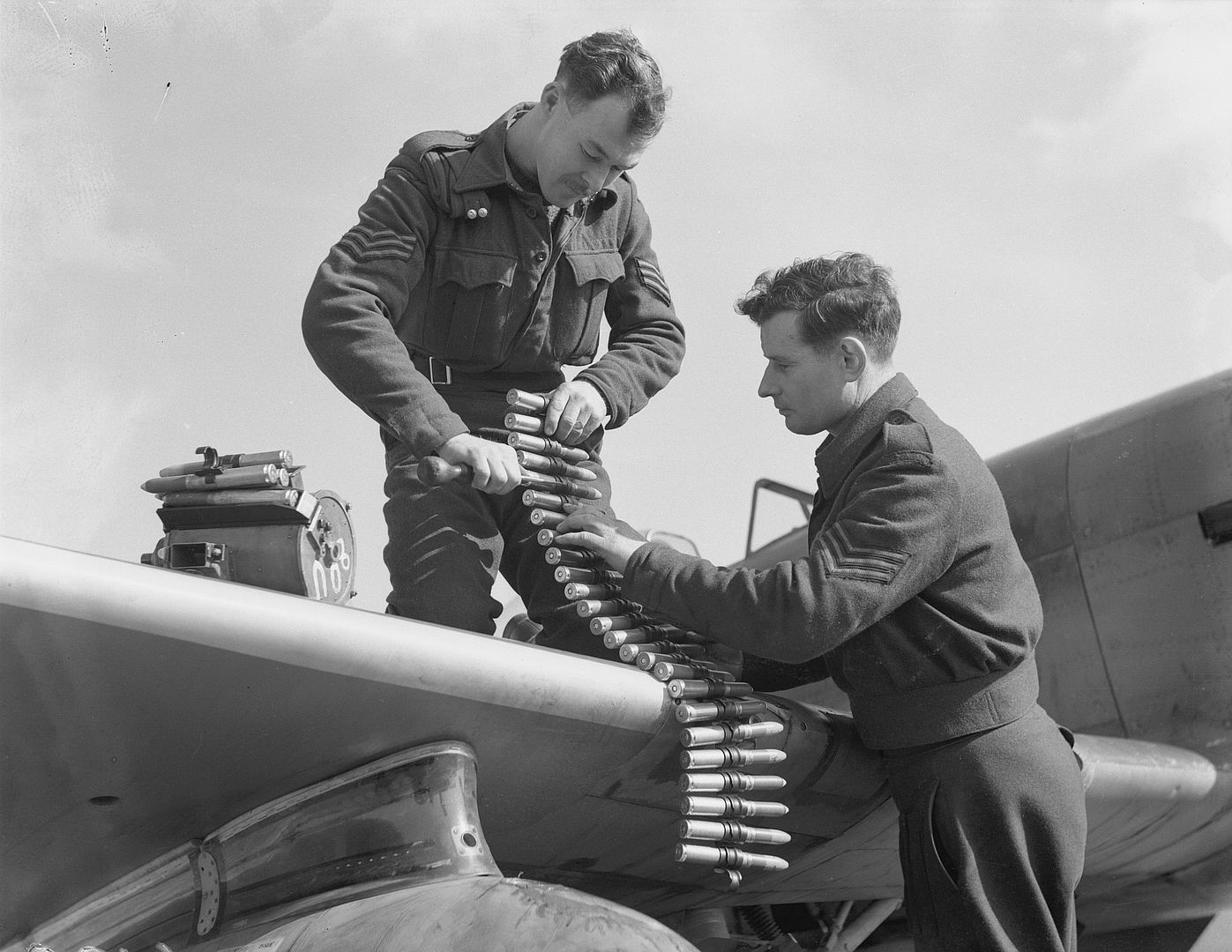


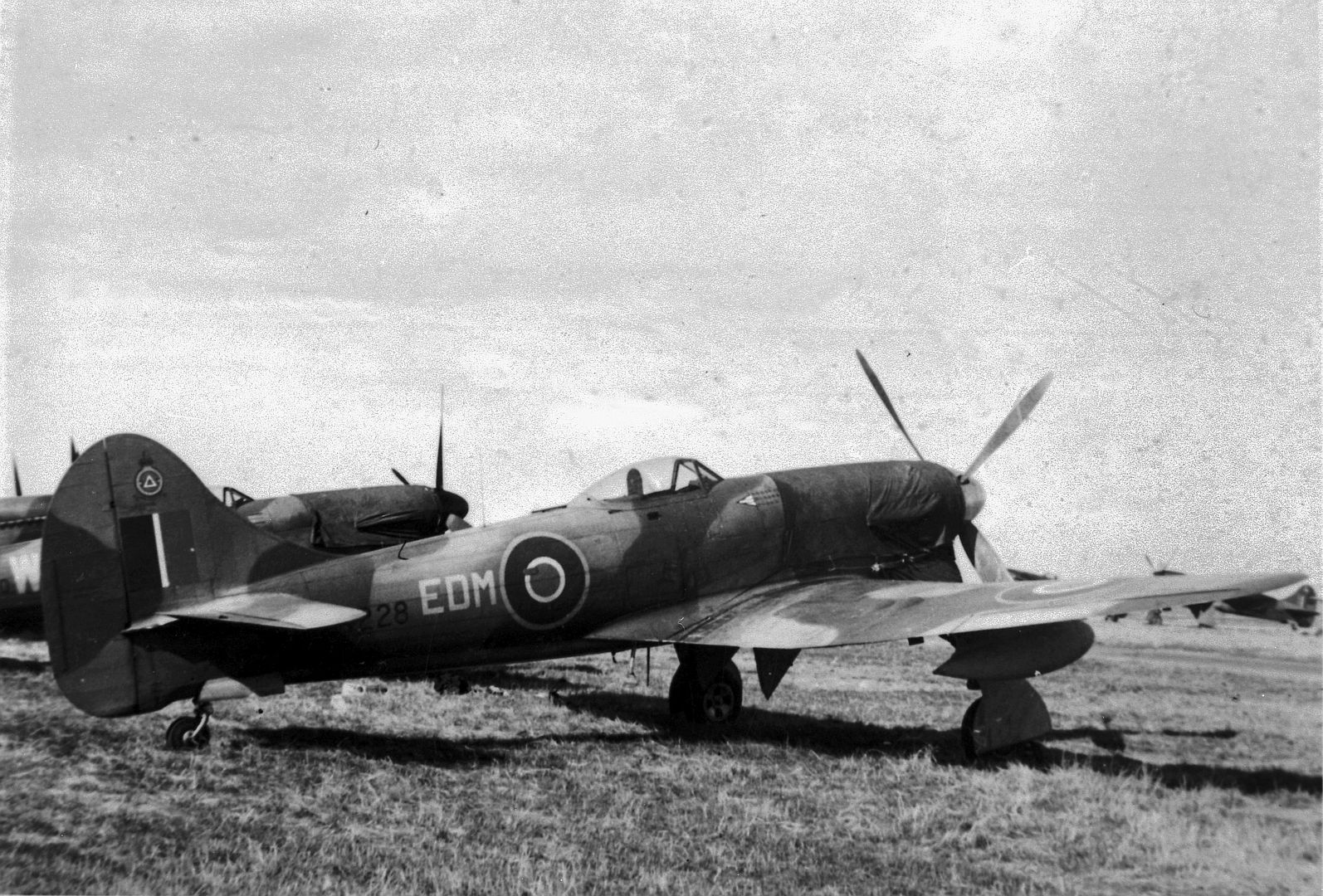






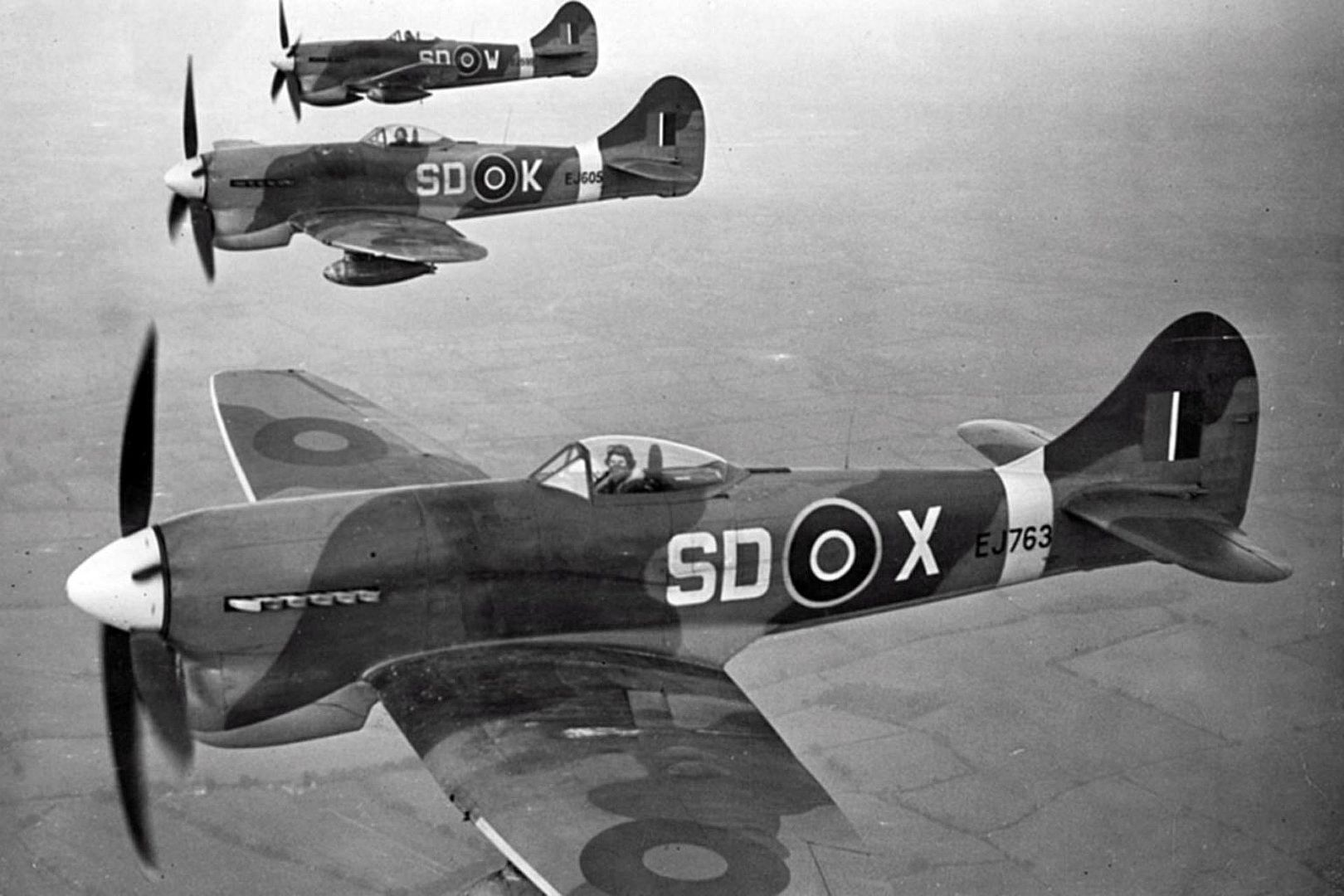


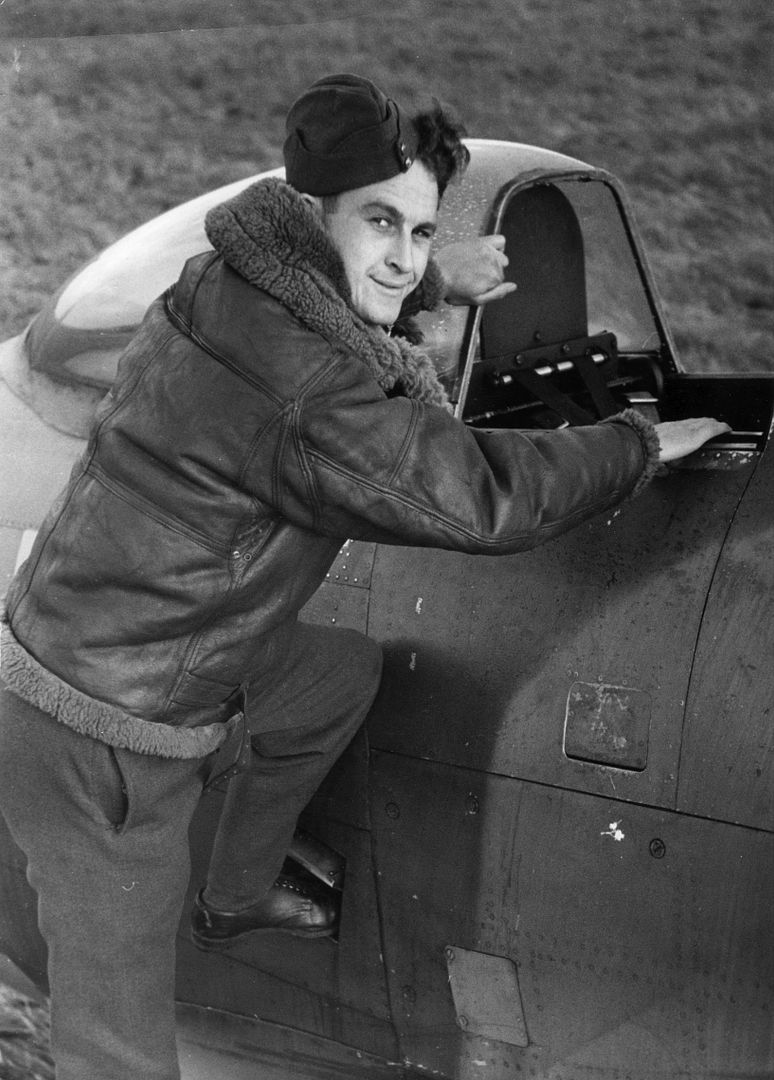










Tempest Mk.II LINK -- http://axis-and-allies-paintworks.com/e107_plugins/forum/forum_viewtopic.php?id=18641
Tempest Mk.VI
Various engineering refinements that had gone into the Tempest II were incorporated into the last Tempest variant, designated as the Tempest VI. This variant was furnished with a Napier Sabre V engine with 2,340 hp (1,700 kW). The more powerful Sabre V required a bigger radiator which displaced the oil cooler and carburettor air intake from the radiator's centre; air for the carburettor was drawn through intakes on the leading edge of the inner wings, while the oil cooler was located behind the radiator. Most Tempest VIs were tropicalised, the main feature of this process being an air filter which was fitted in a fairing on the lower centre section. Other changes included the strengthening of the rear spar and the inclusion of spring tabs, which granted the variant superior handling performance.
The original Tempest V prototype, HM595, was extensively modified to serve as the Tempest VI prototype. On 9 May 1944, HM595 made its first flight after its rebuild, flown by Bill Humble. In December 1944, HM595 was dispatched to Khartoum, Sudan to conduct a series of tropical trials. During 1945, a further two Tempest V aircraft, EJ841 and JN750, were converted to the Tempest VI standard in order to participate in service trials at RAF Boscombe Down.
At one point, 250 Tempest VIs were on order for the RAF; however, the end of the war led to many aircraft programs being cut back intensively, leading to only 142 aircraft being completed. For a long time, it was thought there were Tempest VIs that had been converted for target towing purposes; however, none of the service histories of the aircraft show such conversions and no supporting photographic evidence has been found. The Tempest VI holds the distinction of being the last piston-engined fighter in operational service with the RAF, having been superseded by jet propelled aircraft.


Design
The Tempest was a single engine fighter aircraft that excelled at low-level flight. In service, its primary role soon developed into performing "armed reconnaissance" operations, often deep behind enemy lines. The Tempest was particularly well suited to the role because of its high speed at low to medium altitudes, its long range when equipped with two 45-gallon drop tanks, the good firepower of the four 20mm cannon and the good pilot visibility. The three-piece windscreen and side windows of the Tempest had directly benefited from examination of captured Focke-Wulf Fw 190s, improvements included the careful design and positioning of the frame structure, blind spots being reduced to an absolute minimum. It had a bullet-resistant centre panel made up of two layers, the outer 1.5 in (38 mm) thick and the inner 0.25 in (6.5 mm).
The majority of production Tempests were powered by a single high-powered Napier Sabre II 24-cylinder engine. All versions of the Sabre drove either a four-bladed, 14 ft (4.267 m) diameter de Havilland Hydromatic or Rotol propeller. Starting with EJxxx series, on the Tempest V, both the improved Sabre IIB and IIC were used, these engines were capable of producing over 2,400 hp (1,789 kW) on emergency boost for short periods of time. Alternative engines were used on some production variants, such as the Tempest II, for which a single Bristol Centaurus 18 cylinder radial engine was adopted, or the final Tempest VI, upon which a Napier Sabre V was used. Early on in development, the adoption of several other engines was proposed, some of which were tested upon multiple prototypes.
The wing of the Tempest was one of its more significant design features, having been developed from the Typhoon to use a thinner laminar flow design approach. The wing planform was of a near-elliptical shape; the aircraft's armament of four 20 mm Hispano cannons with 800 rounds of ammunition was also embedded into the wing.The ailerons were fitted with spring-loaded tabs which lightened the aerodynamic loads, making them easier for the pilot to use and dramatically improving the roll rate above 250 mph (402 km/h). The spar structure of the Tempest V also allowed the wings to carry up to 2,000 lb (907 kg) of external stores. Also developed specifically for the Tempest by Hawker was a streamlined 45 gal (205 L) "drop tank" to extend the operational radius by 500 mi (805 km) and carrier fairing; the redesigned wing incorporated the plumbing for these tanks, one to each wing.
The main undercarriage was redesigned from the Typhoon, featuring lengthened legs and a wider track (16 ft/4.9 m) to improve stability at the high landing speed of 110 mph (177 km/h), and to allow tip clearance for a new de Havilland 14 ft (4.26 m) diameter four-blade propeller. The main undercarriage units were Dowty levered suspension units incorporating trunnions which shortened the legs as they retracted.The retractable tailwheel was fully enclosed by small doors and could be fitted with either a plain Dunlop manufactured tyre, or a Dunlop-Marstrand "twin-contact" anti-shimmy tyre.
During development, Camm and the Hawker design team had placed a high priority on making the Tempest easily accessible to both air and ground crews; to this end, the forward fuselage and cockpit areas of the earlier Hurricane and the Tempest and Typhoon families were covered by large removable panels providing access to as many components as possible, including flight controls and engine accessories. Both upper wing roots incorporated panels of non-slip coating. For the pilot a retractable foot stirrup under the starboard root trailing edge was linked to a pair of handholds which were covered by spring-loaded flaps. Through a system of linkages, when the canopy was open the stirrup was lowered and the flaps opened, providing easy access to the cockpit; as the canopy was closed, the stirrup was raised into the fuselage and the flaps snapped shut.
Combat
By April 1944, the Tempest V had attained general acceptance and was in the hands of operational squadrons; 3 Squadron was the first to be fully equipped, closely followed by 486 (NZ) Squadron (the only Article XV squadron to be equipped with the Tempest during the Second World War), replacing their previous Typhoons. A third unit—56 Squadron—initially kept its Typhoons and was then temporarily equipped with Spitfire IXs until sufficient supplies of Tempests were available. By the end of April 1944, these units were based at RAF Newchurch in Kent a new "Advanced Landing Ground" (ALG), where they formed 150 Wing, commanded by Wing Commander Roland Beamont. The new Wing was part of the Second Tactical Air Force (2nd TAF).
Most of the operations carried out by 150 Wing comprised high-altitude fighter sweeps, offensive operations known as "Rangers", as well as reconnaissance missions. Prior to the Normandy landings, Tempests would routinely conduct long-range sorties inside enemy territory and penetrate into Northern France and the Low Countries, using a combination of cannons and bombs to attack airfields, radar installations, ground vehicles, coastal shipping and the launch sites for the German V-1 flying bombs.The build-up of Tempest-equipped squadrons was increased rapidly, in part due to factors such as the V-1 threat, although a labour strike in Hawker's assembly shop adversely affected this rate; by September 1944, a total of five frontline Tempest squadrons which comprised 114 aircraft were in operation.
In June 1944, the first of the V-1s were launched against London; the excellent low-altitude performance of the Tempest made it one of the preferred tools for handling the small fast-flying unmanned missiles. 150 Wing was transferred back to the RAF Fighter Command; the Tempest squadrons soon racked up a considerable percentage of the total RAF kills of the flying bombs (638 of a total of 1,846 destroyed by aircraft). Using external drop tanks, the Tempest was able to maintain standing patrols of 4.5 hours off the south coast of England in the approach paths of the V-1s. Guided by close instructions from coastal radar installation, Tempests would be positioned ready for a typical pursuit and would either use cannon fire or nudge the V-1 with the aircraft itself to destroy it.
LINK -- http://axis-and-allies-paintworks.com/e107_plugins/forum/forum_viewtopic.php?id=363
In September 1944, Tempest units, based at forward airfields in England, supported Operation Market Garden, the airborne attempt to seize a bridgehead over the Rhine. On 21 September 1944, as the V-1 threat had receded, the Tempest squadrons were redeployed to the 2nd TAF, effectively trading places with the Mustang III squadrons of 122 Wing, which became part of the Fighter Command units deployed on bomber escort duties. 122 Wing now consisted of 3 Sqn., 56 Sqn., 80 Sqn., 274 Sqn. (to March 1945), and 486(NZ)Sqn. From 1 October 1944 122 Wing was based at B.80 Volkel Air Base near Uden, in the Netherlands. During the early phase of operations, the Tempest regularly emerged victorious and proved to be a difficult opponent for the Luftwaffe's Bf 109G and Fw 190 fighters to counter.
Armed reconnaissance missions were usually flown by two sections (eight aircraft), flying in finger-four formations, which would cross the front lines at altitudes of 7,000 to 8,000 feet: once the Tempests reached their allocated target area the lead section dropped to 4,000 feet or lower to search for targets to strafe, while the other section flew cover 1,000 feet higher and down sun. After the first section had carried out several attacks, it swapped places with the second section and the attacks continued until all ammunition had been exhausted, after which the Tempests would return to base at 8,000 ft. As many of the more profitable targets were usually some 250 miles from base, the Tempests typically carried two 45-gallon drop tanks which were turned on soon after takeoff. Although there were fears that the empty tanks would explode if hit by flak, the threat never eventuated and, due to the tanks being often difficult to jettison, they were routinely carried throughout an operation with little effect on performance, reducing maximum speed by 5 to 10 mph and range by 2 per cent.
Between October and December 1944, the Tempest was practically withdrawn from combat operations for overhaul work, as well as to allow operational pilots to train newcomers. The overhaul process involved the replacement or major servicing of their engines and the withdrawal of the limited number of aircraft which were equipped with spring-tabs; these increased manoeuvrability so much that there was a risk of damaging the airframe. In December 1944, upon the Tempest's reentry into service, the type had the twin tasks of the systematic destruction of the North German rail network along with all related targets of opportunity, and the maintenance of air supremacy within the North German theatre, searching for and destroying any high performance fighter or bomber aircraft of the Luftwaffe, whether in the air or on the ground.
In December 1944, a total of 52 German fighters were downed, 89 trains and countless military vehicles were destroyed, for the loss of 20 Tempests. Following the Luftwaffe's Unternehmen Bodenplatte of 1 January 1945, 122 Wing bore the brunt of low- to medium-altitude fighter operations for the Second Tactical Air Force, which had fortuitously evaded the extensive Bodenplatte raid, and had contributed to efforts to intercept the raiders. During this time, Spitfire XIVs of 125 and 126 Wings often provided medium- to high-altitude cover for the Tempests, which came under intense pressure, the wing losing 47 pilots in January. In February 1945, 33 and 222 Sqns. of 135 Wing converted from Spitfire Mk IXs and, in March, were joined by 274 Sqn. 135 Wing was based at B.77 Gilze-Rijen airfield in the Netherlands.The intensity of operations persisted throughout the remainder of the war.
Against advanced German planes
Piloting a Tempest on 19 April 1945, Flying Officer Geoffrey Walkington was the first to shoot down a Heinkel He 162, the Luftwaffe's then-latest jet fighter, which had just entered service with the I./JG 1 (1st Group of Jagdgeschwader 1 Oesau — "1st Fighter Wing"). During this encounter over Husum, the German pilot Feldwebel Günther Kirchner was the first to attempt using the He 162's cartridge-type ejector seat under combat conditions, but unfortunately he was too low and his parachute failed to open.
Also flying a Tempest, French ace Pierre Clostermann claimed the first Allied combat encounter with a Dornier 335 in April 1945. In his book The Big Show he describes leading a flight of Hawker Tempests from No. 3 Squadron RAF over northern Germany, when they saw a lone unusual looking aircraft flying at maximum speed at treetop level. Detecting the British aircraft, the German pilot reversed course to evade. Despite the Tempests' considerable low altitude speed, Clostermann decided not to attempt to follow as it was obviously much quicker though one of the other two Tempests did pursue it briefly.
During 1945, a noteworthy accomplishment of the Tempest was the scoring of a number of kills against the new German jets, including the Messerschmitt Me 262. Hubert Lange, a Me 262 pilot, said: "the Messerschmitt Me 262's most dangerous opponent was the British Hawker Tempest — extremely fast at low altitudes, highly manoeuvrable and heavily armed."
Some Me 262s were destroyed using a tactic known to 135 Wing as the "Rat Scramble"; Tempests on immediate alert took off when an Me 262 was reported to be airborne. They did not directly intercept the jet, but instead flew towards the Me 262 and Ar 234 base at Rheine-Hopsten. The aim was to attack jets on their landing approach, when they were at their most vulnerable, travelling slowly, with flaps down and incapable of rapid acceleration. The Germans responded by creating a "flak lane" of over 150 of the Flakvierling quadruple 20 mm (.79 in) AA batteries at Rheine-Hopsten, to protect the approaches.After seven Tempests were lost to anti-aircraft fire at Rheine-Hopsten in a single week, the "Rat Scramble" was discontinued. For a while, in March 1945, a strict "No, repeat, No ground attacks" policy was imposed; this only applied for a few days.
In air-to-air combat, the Tempest units achieved an estimated air combat success ratio of about 8:1, scoring 239 confirmed victories (not including the additional "victories" against the unmanned V-1 flying bomb), 9 probable victories; losses: 31 including probable ones).
The top-scoring Tempest pilot was Squadron Leader David Fairbanks DFC, an American who joined the Royal Canadian Air Force in 1941. By mid-1944, he was flying with 274 Squadron. When he was shot down and made a prisoner of war in February 1945, he had destroyed 11 or 12 German aircraft (and one shared), to make him the highest-scoring Tempest ace.
Other activities
Early flights by RAF pilots found the Tempest, unlike the Typhoon, was buffet-free up to and somewhat beyond 500 mph (800 km/h).During 1944, several veteran USAAF pilots flew the Tempest in mock combat exercises held over the south of England; the consensus from these operations was that it was roughly akin to the American Republic P-47 Thunderbolt. According to aviation author Francis K. Mason, the Tempest was commonly accepted as the best–performing RAF fighter in operational service by VE Day. Following the end of the war, the RAF decided upon the Tempest as its standard fighter, pending the introduction of newer aircraft, many of which would be developed post-war, such as the de Havilland Hornet and the de Havilland Vampire, as well as the Gloster Meteor. A number of squadrons would operate the Tempest as their final piston-engined type before converting to the new generation of jet-powered fighter aircraft that would come to dominate the next decade and beyond.
The later Tempest Mk.II was tropicalised as it had been decided that this variant would be intended for combat against Japan. The envisioned role for the type would have been as a purpose-built type which would participate in the Tiger Force, which was a proposed British Commonwealth long-range bomber force to have been stationed on Okinawa as a forward base for operations against the Japanese mainland. Before the Tempest Mk.II entered operational service, the Pacific War ended.By October 1945, a total of 320 Tempest IIs had been delivered to maintenance units stationed at RAF Aston Down and RAF Kemble; these aircraft were mainly dispatched to squadrons stationed overseas in Germany and in India, along with other locations such as Hong Kong and Malaysia. On 8 June 1946, a Tempest II, flown by Roland Beamont, led the flypast at the London Victory Celebrations of 1946. RAF Tempest IIs saw combat use against guerrillas of the Malayan National Liberation Army during the early stages of the Malayan Emergency.
A total of 142 Tempest Mk VI were produced, which equipped nine squadrons of the RAF, five of these being stationed in the Middle East due to its suitability for such environments. This particular variant was anticipated to have a short lifetime and their phasing out commenced in 1949. During the 1950s, the Tempest was mainly used in its final capacity as a target tug aircraft In 1947, the RAF transferred a total of 89 Tempest FB IIs to the Indian Air Force (IAF), while another 24 were passed on to the Pakistani Air Force (PAF) in 1948. Both India and Pakistan would operate the Tempest until 1953.
Specifications (Tempest Mk.V)
General characteristics
Crew: 1
Length: 33 ft 8 in (10.26 m)
Wingspan: 41 ft 0 in (12.50 m)
Height: 14 ft 10 in (4.52 m) (tail in rigging position with one propeller blade vertical) ; 16 ft 1 in (4.90 m) (tail down with one propeller blade vertical)
Wing area: 302 sq ft (28.1 m2)
Airfoil: root:Hawker H.14/14/37.5 ; tip:Hawker H.14/10/37.5 (maximum thickness at 37.5% chord)
Gross weight: 11,400 lb (5,171 kg) as interceptor; 12,500 lb (5,700 kg) with 2x 500 lb (230 kg) bombs; 13,500 lb (6,100 kg) with 2x 1,000 lb (450 kg) bombs)
Fuel capacity: 160 imp gal (190 US gal; 730 l) internal with optional 90 imp gal (110 US gal; 410 l) or 180 imp gal (220 US gal; 820 l) in two drop tanks under wings
Oil tank capacity: 16 imp gal (19 US gal; 73 l)
Powerplant: 1 × Napier Sabre IIB H-24 liquid-cooled sleeve-valve piston engine, 2,420 hp (1,800 kW) at + 11 lb boost for 5 minutes at sea level ; 2,010 hp (1,500 kW) for take-off ; 2,045 hp (1,525 kW) at 13,750 ft (4,190 m)
Propellers: 4-bladed de Havilland Hydromatic, 14 ft (4.3 m) diameter constant-speed propeller
Performance
Maximum speed: 435 mph (700 km/h, 378 kn) at 17,000 ft (5,200 m) ; 390 mph (340 kn; 630 km/h) at sea level
Combat range: 420 mi (680 km, 360 nmi)
Service ceiling: 36,500 ft (11,100 m)
Rate of climb: 4,700 ft/min (24 m/s)
Time to altitude: 20,000 ft (6,100 m) in 6 minutes at combat power
Wing loading: 44.7 lb/sq ft (218 kg/m2) at 13,500 lb (6,100 kg)
Power/mass: 0.149 hp/lb (0.245 kW/kg) at 13,500 lb (6,100 kg)
Armament
4 × 20 mm (0.787 in) Mark II Hispano cannon, 200 rpg. Later models used Mark V Hispano cannon.
with
2 × 500 lb (230 kg) or 1,000 lb (450 kg) bombs
8 × 3 in (76.20 mm) RP-3 rockets (post-Second World War)
Provision for 2 × 45 imp gal (54 US gal; 200 l) or 2 × 90 imp gal (110 US gal; 410 l) drop tanks.
(Text from Wikki)
Post a reply
- Go to Previous topic
- Go to Next topic
- Go to Welcome
- Go to Introduce Yourself
- Go to General Discussion
- Go to Screenshots, Images and Videos
- Go to Off topic
- Go to Works in Progress
- Go to Skinning Tips / Tutorials
- Go to Skin Requests
- Go to IJAAF Library
- Go to Luftwaffe Library
- Go to RAF Library
- Go to USAAF / USN Library
- Go to Misc Library
- Go to The Ops Room
- Go to Made in Germany
- Go to Campaigns and Missions
- Go to Works in Progress
- Go to Juri's Air-Raid Shelter
- Go to Campaigns and Missions
- Go to Works in Progress
- Go to Skinpacks
- Go to External Projects Discussion
- Go to Books & Resources
